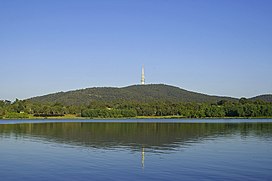Black Mountain (Australian Capital Territory)
| Black Mountain | |
|---|---|
| Black Hill | |
 Black Mountain and Black Mountain Tower as seen from across Lake Burley Griffin. | |
| Highest point | |
| Elevation | 812 m (2,664 ft)[1] |
| Prominence | 256 m (840 ft) |
| Coordinates | 35°16′S 149°06′E / 35.267°S 149.100°E |
| Geography | |
| Location | Australian Capital Territory, Australia |
| Geology | |
| Volcanic arc/belt | Silurian |
| Climbing | |
| First ascent | 1820[2] |
| Easiest route | Hike or drive |
Black Mountain is a small mountain with an elevation of 812 metres (2,664 ft) AHD that is situated to the west of the Canberra central business district on the northern shore of Lake Burley Griffin, in the Australian Capital Territory of Australia. Black Mountain is protected from development by the Canberra Nature Park and is predominantly covered in native bushland and is a haven to native wildlife.
Location and features
The mountain is located west of the main campus of the Australian National University and, together with the Bruce ridge, forms a natural west and northwestern boundary for Canberra city. Black Mountain rises 256 metres (840 ft) above the water level of Lake Burley Griffin that lies at its base. Situated close to the highest point on the mountain is Black Mountain Tower (previously known as Telstra Tower, and Telecom Tower), a broadcasting tower rising a further 195 metres (640 ft) above the summit.
The Australian National Botanic Gardens and the CSIRO share the eastern base of Black Mountain, next to the Australian National University.
Black Mountain was originally named Black Hill at the same time as the naming of nearby Red Hill.[3] The original name explains why the mountain is not now known as Mount Black like nearby Mount Majura and Mount Ainslie. The early European settlers referred to the mountain formation as the Canberry Ranges.[4]
Geology
The bulk of Black Mountain consists of the white quartz Black Mountain Sandstone. This was deposited in the late early Silurian age. On the south east slopes and north west there are exposures of State Circle shale. The Black Mountain Peninsula contains mudstone in the north and greywacke from the Ordovician age Pittman Formation in the south.[5]
References
- ^ "Black Mountain, Australia". Peakbagger.com. Retrieved 11 October 2013.
- ^ "The Story of Canberra - Yesterday's Canberra". Retrieved 2 March 2014.
- ^ Sneddon, George. "The GENIUS LOCI and Australian Landscape". Centre for Environmental Studies. University of Melbourne. Retrieved 2 March 2014.
- ^ Wilson, Gwendoline. Murry of Yarralumla. Tabletop Press. p. 186.
- ^ Henderson, G. A. M.; Matveev, G. (1980). Geology of Canberra, Queanbeyan and Environs (Map). 1:50000.
External links
![]() Media related to Black Mountain (Australian Capital Territory) at Wikimedia Commons
Media related to Black Mountain (Australian Capital Territory) at Wikimedia Commons

